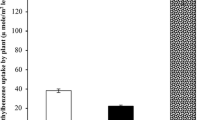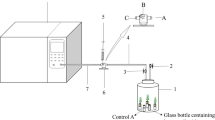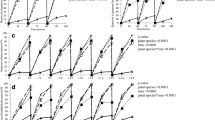Abstract
Zamioculcas zamiifolia has the potential to reduce the concentration of benzene, toluene, ethylbenzene, and xylene (BTEX) from contaminated indoor air. It can remove all four pollutant gases. Benzene, toluene, ethylbenzene, and xylene uptake per unit area of Z. zamiifolia leaf were about 0.96 ± 0.01, 0.93 ± 0.02, 0.92 ± 0.02, and 0.86 ± 0.07 mmol m−2 at 72 h of exposure, respectively. The physicochemical properties of each BTEX may affect its removal. Benzene, a smaller molecule, is taken up by plants faster than toluene, ethylbenzene, and xylene. The toxicity of BTEX on plant leaves and roots was not found. The chlorophyll fluorescence measurement (F v/F m) showed no significantly difference between controlled and treated plants, indicating that a concentration of 20 ppm of each gas is not high enough to affect the photosynthesis of the plants. The ratio of stomata and cuticles showed that 80 % of benzene, 76 % of toluene, 75 % of ethylbenzene, and 73 % of xylene were removed by stomata pathways, while 20, 23, 25, and 26 % of them were removed by cuticles. The BTEX removal efficiency by well-watered Z. zamiifolia was involved with day stomata opening and night closing, while the BTEX removal efficiency by water-stressed Z. zamiifolia can occur both day and night at a slightly lower rate than well-watered plants.







Similar content being viewed by others
References
Baduru, K. K., Trapp, S., & Burken, J. G. (2008). Direct measure of VOC diffusivities in tree tissue: Impacts on tree-based phytoremediation and plant contamination. Environmental Science and Technology, 42, 1268–1275.
Baker, N. R. (1991). A possible role for photosystem II in environmental perturbations of photosynthesis. Physiologia Plantarum, 81, 563–570.
Bodalal, A., Zhang, J. S., & Plett, E. G. (2000). A method for measuring internal diffusion and equilibrium coefficients of VOCs for building material. Building and Environment, 35, 101–110.
Chen, J. J., & Henny, R. J. (2003). ZZ: A unique tropical ornamental foliage plant. HortTechnology, 13, 458–462.
Cornejo, J. J., Munoz, G. F., Ma, Y. C., & Stewart, J. A. (1999). Studies on the decontamination of air by plants. Ecotoxicology, 8, 311–320.
Esplugues, A., Ballester, F., Estarlich, M., Llop, S., Fuentes-Leonarte, V., Mantilla, E., et al. (2010). Indoor and outdoor air concentrations of BTEX and determinants in a cohort of one-year old children in Valencia, Spain. Science of the Total Environment, 409, 63–69.
Guieysse, B., Hort, C., Platel, V., Munoz, R., Ondarts, M., & Revah, S. (2008). Biological treatment of indoor air for VOC removal: Potential and challenges. Biotechnology Advances, 26, 398–410.
Holtum, A. M. J., Winter, K., Weeks, A. M., & Sexton, R. T. (2007). Crassulacean acid metabolism in ZZ plant, Zamioculcas zamiifolia (Aeaceae). American Journal of Botany, 94(10), 1670–1676.
Jen, M. S., Hoylman, M. A., Edwards, T. N., & Walton, T. B. (1995). Gaseous deposition of 14C-toluene to soybean (Glycine max) foliage. Environmental and Experimental Botany, 35, 389–398.
Keymeulen, R., Schamp, N., & Van Langenhove, H. (1993). Factors effecting airborne monocyclic aromatic hydrocarbon uptake by plants. Atmospheric Environment, 27A, 175–180.
Kvesitadze, E., Sadunishvili, T., & Kvesitadze, G. (2009). Mechanisms of organic contaminants uptake and degradation in plants. Engineering and Technology, 55, 458–468.
Lin, S. Q., Xu, C. H., Zhang, Q. D., Xu, L., Mao, D. Z., & Kuang, T. Y. (1992). Some application of chlorophyll fluorescence kinetics to plant stress physiology, phytoecology and agricultural modernization. Chinese Bulletin of Botany, 9, 1–16.
Little, J. C., Hodgson, A. T., & Gadgil, J. A. (1994). Modeling emissions of volatile organic compounds from new carpets. Atmospheric Environment, 28(2), 227–234.
Liu, Y., Mu, Y., Zhu, Y., Ding, H., & Arens, N. (2007). Which ornamental plant species effectively remove benzene from indoor air? Atmospheric Environment, 41, 650–654.
Nelson, M., & Wolverton, B. C. (2011). Plants + soil/wetland microbes: Food crop systems that also clean air and water. Advances in Space Research, 47, 582–590.
Ribas-Carbo, M., Taylor, N. L., Giles, L., Busquets, S., Finnegan, M. P., Day, A. D., et al. (2005). Effects of water stress on respiration in soybean leaves. Plant Physiology, 139, 466–473.
Treesubsuntorn, C., & Thiravetyan, P. (2012). Removal of benzene from indoor air by Dracaena sanderiana: Effect of wax and stomata. Atmospheric Environment, 57, 317–321.
Wolverton B.C. (1996). How to grow fresh air. New York: Penguin Book.
Wood, R., Orwell, R., Tarran, J., MAIH, & Burchett, M. (2001). Pot-plants really do clean indoor air. The Nursery Papers, 1–4.
Acknowledgments
The authors would like to thank the Thailand Research Fund for supporting this research through the Royal Golden Jubilee Ph.D. Program and King Mongkut’s University of Technology Thonburi (grant number PHD/0284/2552).
Author information
Authors and Affiliations
Corresponding author
Rights and permissions
About this article
Cite this article
Sriprapat, W., Thiravetyan, P. Phytoremediation of BTEX from Indoor Air by Zamioculcas zamiifolia . Water Air Soil Pollut 224, 1482 (2013). https://doi.org/10.1007/s11270-013-1482-8
Received:
Accepted:
Published:
DOI: https://doi.org/10.1007/s11270-013-1482-8




